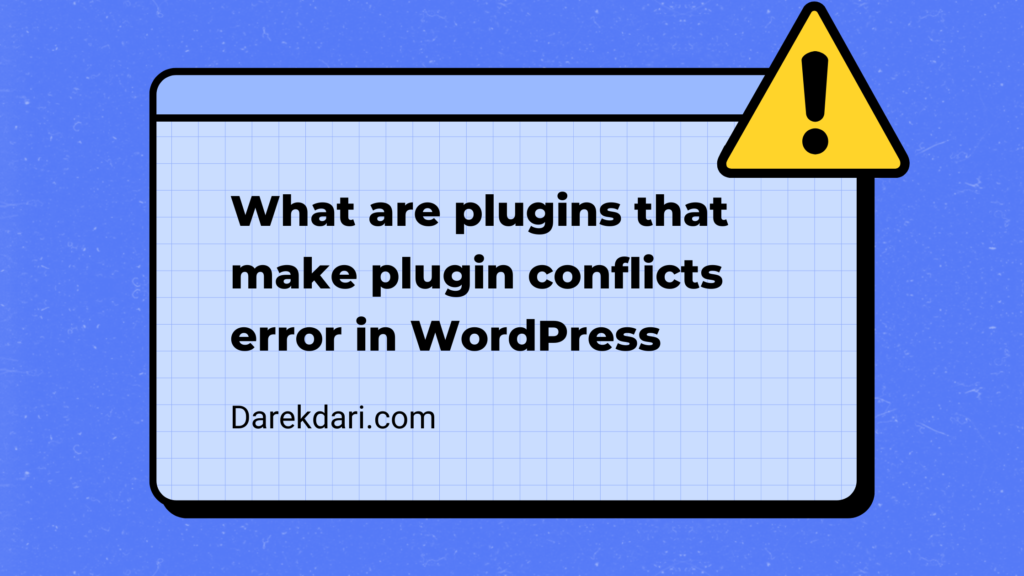
Table of Contents
Listen up fam, building a fly WordPress site be smooth sailin’ most of the time. But hold up, sometimes you hit a snag. You add a hot new plugin to make your site poppin’, but then BAM! Everything goes sideways.
Yoast SEO throws an error, Elementor lookin’ all buggy, and your site lookin’ like a mess. This my friends, is a classic case of plugin conflicts. Don’t fret though, we gonna break this down, diagnose the issue, and get yo site back on fleek
What’s the Deal with Plugin Conflicts?
Imagine this, you got two plugins that are both tryna flex their muscles and be the center of attention.
One plugin might be sayin’ “Yo, I gotta control how images load!”
While the other one screamin’ back “Nah fam, that’s my territory!” This back-and-forth tussle can cause errors and mess up your site.
It’s like two rappers dissing each other on the same track, confusing and frustrating for everyone involved
Here’s the lowdown on why plugins clash:
- They Steppin’ on Each Other’s Toes: Like we said before, plugins might have overlapping functionalities. This redundancy can lead to errors and unexpected behavior.
- Resource Rumble: Plugins be hungry for resources like server space and memory. If two plugins are hogging all the resources, it can slow down your site or cause crashes.
- Outdated Threads: Just like yo favorite kicks wear out, plugins need updates to stay fresh. An outdated plugin might not play nice with newer plugins or your WordPress version.
Common Plugin Conflicts Symptoms
Yo site might be exhibiting these signs if it’s caught in a plugin war 🩺:
- Error Messages Galore: You seein’ cryptic error messages poppin’ up everywhere? This could be a sign of plugins throwin’ punches at each other.
- Features on the Fritz: Plugins that ain’t working right? Images not loading? Buttons not responding? This could be a result of conflicting plugins.
- Slow and Laggy Site: If your site is movin’ slower than molasses in December, it might be due to plugins bogging things down.
How to Find the Culprit ️
Alright, so your site is acting buggy. We gotta identify which plugins are the troublemakers. Here’s how you can play detective:
- The Minimalist Approach: This is like taking your site back to basics. Deactivate all your plugins and see if the issue persists. If your site starts working smoothly, then you know a plugin is to blame.
- Divide and Conquer: Slowly reactivate your plugins one by one after deactivating all of them. After each reactivation, test your site to see if the problem comes back. This will help narrow down the culprit.
- The Plugin Deactivation Dance: WordPress has a handy dandy tool called Health Check & Troubleshooting. This bad boy allows you to temporarily deactivate plugins for just your admin view. This way, you can test plugins without affecting your live site.
Tools of the Trade Busting Plugin Conflicts
While deactivating plugins can help diagnose the problem, it ain’t always the ideal solution. Sometimes you need both plugins! This is where these helpful plugins come in:
- Health Check & Troubleshooting (built-in): We mentioned this before, but it deserves another shoutout. This built-in plugin is a lifesaver for diagnosing conflicts.
- Better Plugin Compatibility Checker: This bad boy proactively scans your plugins for potential conflicts before you install them. Prevention is key, yo!
Pro Tip: Always keep your WordPress core, themes, and plugins updated. Updates often include bug fixes and compatibility improvements that can help prevent conflicts.
How to Avoid Plugin Conflicts ️
Listen up, we can stop these plugin wars before they even start. Here’s how to be a smart plugin installer:
- Do Your Research: Before you install a new plugin, check its reviews and see if there are any known conflicts with plugins you’re already using.
- Stick to the Reputable Crew: There’s a lotta shady plugins out there. Stick with plugins from well-known developers with good reputations.
- Keep it Lean, Mean, Plugin Machine: Don’t go
Then, why do Plugin Conflicts or theme conflicts happen?
Ever been cruising on your WordPress site and suddenly everything goes sideways? Images won’t load, buttons don’t work, or maybe you’re greeted by the dreaded white screen of death (WSOD). Uh oh, sounds like you might have a plugin conflict.
What’s the Deal with Plugin Conflicts?
Imagine this: you have two plugins that are both trying to control the same thing on your site, like how images load or how buttons function. This clashing code can cause errors and malfunctions, making your site buggy and frustrating for visitors.
Here’s why plugin conflicts happen:
- Resource Rumble: Plugins need resources like memory and processing power to run smoothly. If two complex plugins are fighting for resources, it can slow down your site or cause crashes.
- Code Calamity: Sometimes plugins have poorly written code that interferes with other plugins or your theme. Think of it like two programs speaking different languages and getting confused.
- Update Upsets: Updating a plugin or your WordPress core can sometimes create compatibility issues, leading to conflicts with other plugins or your theme.
Signs Your Site is Caught in a Plugin War
- Error Extravaganza: Are cryptic error messages popping up everywhere? This could be a sign of plugins throwing shade at each other.
- Features on the Fritz: Buttons not working? Images not loading? These malfunctions could be caused by conflicting plugins.
- Slow and Laggy Site: If your site is moving slower than molasses in December, it might be due to plugins bogging things down.
Troubleshooting Plugin Conflicts A Step-by-Step Guide
Yo, we diagnosed the drama plugin conflicts cause on your WordPress site. Now it’s time to roll up your sleeves and fix that mess. Here’s a step-by-step breakdown to get your site back in tip-top shape:
To fix plugin conflicts while you have access to your admin panel:
- Clear your browser cache.
- Make sure your plugins are updated.
- Determine if it’s truly a plugin conflict by ruling out a WordPress version or theme conflict (a staging site is recommended for this).
- Track down the plugins causing the conflict with help from your browser console or, manually deactivate and reactivate each plugin, one by one.
- Replace one or both of the plugins in question, and then report the bug to the developers.

Step 1: Backup Yo Stuff
Before you start tinkering, creating a backup of your WordPress site is crucial. Think of it like an insurance policy. If something goes wrong during troubleshooting, you can easily restore your site to its previous state.
There are many plugins available for creating backups. Here are a popular few:
- UpdraftPlus
- VaultPress
- BlogVault
Step 2: The Minimalist Approach ️♂️
Sometimes the simplest solution is the best. Deactivate all your plugins and see if the issue disappears. If your site magically starts working again, then you know a plugin is to blame.
Manually by visiting the plugins section in your WordPress dashboard and checking each plugin’s compatibility one by one.

Step 3: Divide and Conquer ⚔️
This method is like playing detective. Here’s what to do:
- Deactivate all your plugins.
- Reactivate one plugin at a time.
- After reactivating each plugin, test your site thoroughly to see if the problem returns.
By following these steps, you should be able to pinpoint the exact plugin causing the conflict.
Step 4: Consider Compatibility
If you’ve identified the culprit, check the plugin’s website or documentation for known compatibility issues. There might be an update available that fixes the conflict.
Step 5: Deactivate or Find an Alternative ♂️
If the plugin doesn’t have a fix or you need both plugins for your site, you have a few options:
- Deactivate the conflicting plugin: This might not be ideal, but sometimes it’s necessary.
- Find an alternative plugin: There might be another plugin that offers similar functionality without causing conflicts.
- Contact the plugin developer: Report the conflict to the developer. They might be able to help you or fix the issue in a future update.
How to fix a conflict that causes your site to crash
Uh oh! Looks like your WordPress site got caught in a plugin brawl! Don’t sweat it, though. We can get this fixed up in a jiffy.
Plugins are like roommates. Sometimes they play well together, but other times…not so much. When plugins clash, it can lead to some serious website drama, leaving you with error messages, funky displays, or even the dreaded white screen of death (WSOD).
Here’s the lowdown on what plugin conflicts are and how to get your site back in tip-top shape:
What’s the Beef? Why Do Plugins Fight?
- Resource Rumble: Imagine two plugins trying to grab all the snacks at once. If they both need a lot of resources like memory and processing power, it can lead to a website slowdown or crash.
- Code Calamity: Sometimes plugins have code that doesn’t play nice with others. Think of it like two programs speaking different languages and getting confused.
- Update Upsets: Just like us, plugins need updates to stay fresh. An update to a plugin or your WordPress core might not play nice with other plugins or your theme, causing a conflict.
Signs of Plugin Mayhem
- Error Extravaganza: Strange error messages popping up everywhere? This could be a sign of plugins throwing shade at each other.
- Features on the Fritz: Buttons not working? Images not loading? These malfunctions could be caused by plugins throwing fists.
- Slow and Laggy Site: If your site is moving slower than molasses in December, it might be due to plugins bogging things down.
How to Fix the Mess
- Backup Your Site (Crucial Step!): Before you start wrangling plugins, create a backup of your WordPress site. This is like putting on safety gear before a wrestling match.
- The Minimalist Approach: Sometimes the simplest solution is the best. Deactivate all your plugins and see if the issue disappears. If your site starts working again, then a plugin is to blame.
- Divide and Conquer: This method is like playing detective. Deactivate all your plugins, then reactivate them one by one, testing your site after each reactivation. This will help you identify the specific plugin causing the plugin conflicts.
Bonus Tip: Always keep your WordPress core, themes, and plugins updated. Updates often include bug fixes and compatibility improvements that can help prevent Plugin Conflicts.
If You’re Stuck… Don’t be afraid to call in reinforcements! Search online for solutions or reach out to your WordPress hosting provider for help. They’ve seen it all and can help you get your site back in fighting form.
Absolutely, here’s a guide on how to access your WordPress site’s files and troubleshoot Plugin Conflicts using a secure method:
When Your Site Goes Silent Regaining Access with SFTP
Have you ever encountered a situation where your WordPress site crashes, leaving you locked out of the admin panel? It can be a frustrating experience, but there are ways to regain access and potentially fix the issue.
This guide will show you how to use a Secure File Transfer Protocol (SFTP) program to access your website’s files and potentially resolve the conflict causing the crash.
What You’ll Need
- An SFTP program like FileZilla (available for free download)
- Your website’s hosting login credentials (username and password)
Before You Begin
- Using SFTP involves modifying website files. It’s recommended to be comfortable with navigating file structures and have a recent backup of your site in case of any unexpected issues.
- If you’re unsure about these steps, consider contacting your website hosting provider for assistance. They have the expertise to diagnose and fix the problem for you.
Connecting with SFTP
- Install an SFTP program: Download and install a reputable SFTP program like FileZilla.
- Connect to your website: Launch the SFTP program and enter your website’s hosting login credentials. This will connect you to your website’s files.
- Navigate to Themes and Plugins: Once connected, use the SFTP program to navigate to the folders containing your WordPress themes and plugins. These folders are typically located within the “wp-content” directory.
Resolving the Plugin Conflicts
- Cautiously Deactivate Themes and Plugins: Here comes the troubleshooting part. You can try renaming the folders for themes or plugins you suspect might be causing the conflict. Renaming a folder disables the theme or plugin without deleting it permanently.
- Test Your Website: After renaming a theme or plugin folder, return to your web browser and try to access your website again. If it’s working correctly, you’ve likely identified the culprit. You can then rename the folders of other themes or plugins back to their original names to narrow down the issue.
Important Notes
- Be cautious when modifying website files. Incorrect changes can cause further problems.
- If you’re uncomfortable with SFTP, or if renaming themes/plugins doesn’t resolve the issue, it’s always best to contact your website hosting provider for assistance.
Remember: This method is for troubleshooting purposes only. Once you’ve identified the conflicting theme or plugin, you’ll need to log in to your WordPress admin panel (if possible) to properly address the issue. If you still can’t access your admin panel or your site remains inaccessible, contact your website hosting provider for further assistance.
Bonus Tip: Check for Theme Conflicts for Plugin conflicts Error
While we’ve been focusing on plugin conflicts, sometimes themes can also cause issues. If you’ve gone through all the plugin troubleshooting steps and are still having problems, try switching to a default WordPress theme like Twenty Twenty-Two. If the problem disappears, then your theme might be the culprit.
Here’s a table to summarize the troubleshooting steps:
| Step | Action | Description |
|---|---|---|
| 1 | Backup your site | Create a backup of your WordPress site before making any changes. |
| 2 | Deactivate all plugins | Deactivate all your plugins and see if the issue resolves. |
| 3 | Reactivate plugins one by one | Reactivate plugins one at a time, testing your site after each reactivation. |
| 4 | Check for compatibility issues | See if the problematic plugin has known compatibility issues. |
| 5 | Deactivate or find an alternative | Decide whether to deactivate the plugin, find an alternative, or contact the developer. |
| 6 (Bonus) | Check for theme conflicts | Switch to a default theme to see if the theme is causing the issue. |
How to avoid plugin conflicts
Here are some tips to prevent plugin conflicts in WordPress:
- Make regular backups of your website. This way, if something goes wrong, you can easily restore your site to a working state.
- Use a staging site to test changes before making them to your live site. A staging site is a clone of your live site that you can use to test new plugins, themes, and updates.
- Keep your plugins, themes, and WordPress core updated. Updates often include bug fixes and security patches that can help prevent conflicts.
- Avoid using too many plugins. The more plugins you have, the greater the chance of a conflict. Only install and activate plugins that you need and use regularly.
- Update plugins one at a time. This way, if a conflict occurs, you can easily identify the problematic plugin.
- Be cautious about using outdated plugins. Outdated plugins may not be compatible with newer versions of WordPress or other plugins.
By following these tips, you can help prevent plugin conflicts and keep your WordPress site running smoothly.
Keeping Your WordPress Site Running Smoothly
Plugin conflicts can be a real pain, causing error messages, funky displays, or even the dreaded white screen of death (WSOD). But fear not, WordPress warrior! With a little troubleshooting and some preventative measures, you can keep your site running smoothly.
Here’s a recap of how to fight the plugin conflict beast
- If your site crashes: Don’t panic! You can use SFTP to access your website’s files and potentially identify the culprit.
- To identify the conflict: You can try deactivating all plugins and then reactivating them one by one to see when the issue reappears.
- Once you identify the conflict: You can disable the plugin, find an alternative, or contact the developer for help.
Preventative measures to stop conflicts before they start
- Make regular backups of your site. This way, if something goes wrong during troubleshooting, you can easily restore your site.
- Only install plugins that you really need. The more plugins you have, the greater the chance of a conflict.
- Keep your WordPress core, themes, and plugins updated. Updates often include bug fixes and compatibility improvements that can help prevent conflicts.
Conclusion
Plugins can be super useful tools for WordPress sites, but it’s important to be aware of potential conflicts. By following best practices and learning how to troubleshoot, you can keep your website running smoothly. Great job!
Plugin conflicts can add great functionality but also introduce potential conflicts. By understanding how to troubleshoot these conflicts, you’re well on your way to keeping your WordPress website running smoothly.
Plugin conflicts can supercharge your WordPress site, but they can also introduce conflicts. This guide equipped you to troubleshoot and resolve those conflicts, giving you a better understanding of how plugins work. By keeping your troubleshooting skills sharp and following best practices, you’re well on your way to a website that runs like a champ!
By following these tips, you can keep your WordPress site running smoothly and avoid the drama of Plugin conflicts. Now go forth and conquer the WordPress world!






0 Comments